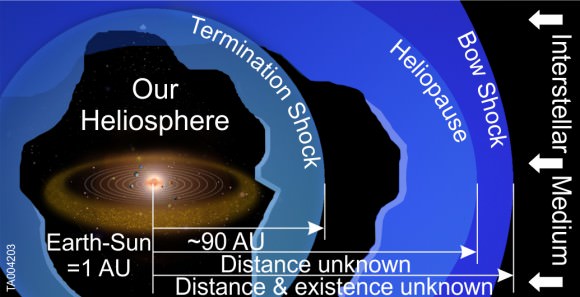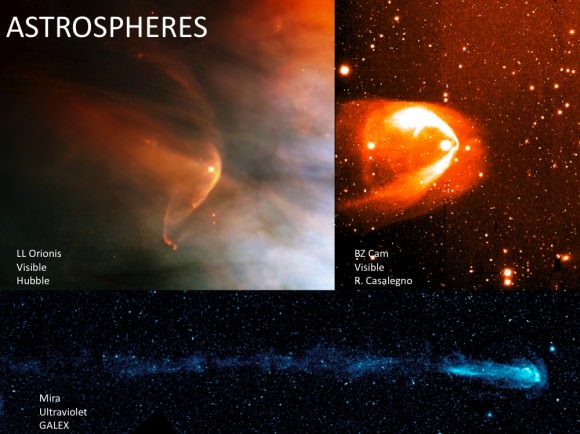[/caption]
If we could board the starship Enterprise-D and were able to look through Giordi LaForge’s visor we might be able to see the interstellar medium – the ‘stuff’ between the stars — as wispy clouds of oxygen, hydrogen, helium and neon. Instead, since we are back in the 21st century, we have the Interstellar Boundary Explorer (IBEX) spacecraft, which has now made the first–ever direct observations of neutral hydrogen and oxygen atoms drifting into our solar system from the region outside our heliosphere. Surprisingly, this material is more ‘alien’ than scientists were expecting, as the matter in the galactic wind doesn’t contain the same exact material as what our solar system is made of.
The most important finding is there is less oxygen ‘out there.’ For every 20 neon atoms in the galactic wind, there are 74 oxygen atoms. In our own solar system, however, for every 20 neon atoms there are 111 oxygen atoms. That translates to more oxygen in any given region of the solar system than in the local interstellar space.
“Our solar system is different than the space right outside it and that suggests two possibilities,” said David McComas the principal investigator for IBEX. “Either the solar system evolved in a separate, more oxygen-rich part of the galaxy than where we currently reside or a great deal of critical, life-giving oxygen lies trapped in interstellar dust grains or ices, unable to move freely throughout space.”
Either way, the scientists said, this affects scientific models of how our solar system – and life – formed. And more than just helping to determine the distribution of elements in the interstellar medium, these new measurements provide clues about how and where our solar system formed, the forces that physically shape our solar system, and even the history of other stars in the Milky Way.
“This alien interstellar material is really the stuff that stars and planets and people are made of — and it’s very important to be measuring it directly,” McComas said during a press briefing on Tuesday.
If Spock were a member of this mission, he would probably raise an eyebrow and say, “Fascinating.”*

Interstellar clouds hold the elements of exploded supernovae, which are dispersed throughout the galaxy. As the interstellar wind blows these charged and neutral particles through the Milky Way, the spacecraft can measure samples that make it into our solar system. IBEX scans the entire sky once a year, and every February, its instruments point in the correct direction to intercept incoming neutral atoms. IBEX counted those atoms in 2009 and 2010 and has now captured the best and most complete glimpse of the material that lies so far outside our own system.
In addition to sampling the raw “star stuff,” the findings are important because the interstellar gas surrounding us can affect the strength of the Sun’s heliosphere – the area of influence by the Sun, and like a shielding bubble, protects us from dangerous galactic cosmic rays, the majority of which would come into the inner solar system if not for this bubble.
IBEX also discovered that the interstellar wind is approximately 7,000 miles per hour slower than previously thought. This indicates that our solar system is still in what’s referred to as the “local interstellar cloud.” However, the scientists noted that we will transition into a different region at any time within a few thousand years (very short on astronomical time scales) where conditions will change and affect the heliosphere’s protective capability. And no one knows if that change will be for the better or worse.
As our solar system travels around the Milky Way through the vast sweep of cosmic time, the ever-changing nature of the heliosphere has likely had implications on the evolution of life on Earth as varying levels of radiation spurred genetic mutations and, perhaps, wholesale extinctions.
“This is all very exciting, and it has important implications as the Sun moves through space and in and out of interstellar clouds , the flux of galactic cosmic rays varies,” said Priscilla Frisch, senior scientist, Department of Astronomy and Astrophysics at the University of Chicago, and part of the IBEX mission. “And that is recorded in the geo-isotopic records. Someday maybe we can link the Sun’s motion through interstellar clouds with geological records on Earth, and trace the geological history of Earth.”

Additionally, while the new findings provide a greater understanding of our heliosphere, it will also aid scientists in exploring analogous structures called “astrospheres,” surrounding other stars throughout the galaxy.
“We know at least two cases of another star with a planetary system and an astrosphere around it, and these are the true analogs to our own solar system,” said Seth Redfield, assistant professor, Astronomy Department, Wesleyan University, in Middletown, Connecticut, also speaking at the press briefing. “The discovery of other planets coupled with our understanding of the impact these galactic cosmic rays could potentially have on planets and the emergence and evolution of life. These are connections that we haven’t explored fully, and with these new findings from IBEX, are now coming together to a very interesting topic to explore.”

IBEX is a small spacecraft, roughly the size of a card table, and is one of NASA’s low-cost missions. It is in Earth orbit, but can observe the edges of the solar system with detectors that “look” outward and collect particles called energetic neutral atoms. With data from IBEX, scientists are creating the first map of the boundary of our solar system.
These latest findings from IBEX were presented in a series of science papers appearing in the Astrophysics Journal on January 31, 2012.
“This set of papers provide many of the first direct measurements of the interstellar medium around us,” says McComas. “We’ve been trying to understand our galaxy for a long time, and with all of these observations together, we are taking a major step forward in knowing what the local part of the galaxy is like.”
For more information: NASA press release, Additional images, videos via Goddard Media Center, Papers: Disconnecting Solar Magnetic Flux, The Interstellar Boundary Explorer (IBEX): Tracing the Interaction between the Heliosphere and Surrounding Interstellar Material with Energetic Neutral Atoms,
*Thanks to Dwayne Brown from NASA for the Spock reference.


“Either the solar system evolved in a separate, more oxygen-rich part of the galaxy than where we currently reside….”
There are many cases of dwarf galaxies merging with much larger galaxies such as the Saggitarius Dwarf galaxy currently merging with the Milky Way.
I wonder if it is ‘possible’ that the Sun was once part of a dwarf galaxy that merged with the Milky Way long ago.
I imagine scientists have already disproved this.
We might think of supernovae as various ovens which cook up elements at different temperatures and pressures. It is then compared to cooking something as different temperatures and coming up with a different result. So there are various regions in the galaxy with different nebular recipes, which stars pass through.
LC
Doing a Google search I see that Bad Astronomy refutes the idea the Sun ever came from a dwarf galaxy. Here’s the link
http://blogs.discovermagazine.com/badastronomy/2007/06/27/is-the-sun-from-another-galaxy/
may mean we’ve moved out of the region our solar system formed in or that particles are trapped ….OR that the act of forming a solar system changes the concentrations of free atoms by liberating or using them. Besides, our solar system didn’t form from tenuous interstellar gases. that would have taken longer than the universe has existed.
The solar system is 4.5Gy old and ‘orbits’ S* every 250,000 years. Wouldn’t it, we, have “moved out” quite a long time ago?
I have no idea what you just said there. I THINK you mean our solar system orbits the centre of our galaxy every 250,000 years. I don’t know what that has to do with anything. “Moved out” is in quotations but I guess you’re not quoting but just emphasizing. And why would we “move out” and are we our solar system? Or are you not really replying to my post at all?
The solar system orbits the galaxy every ~250,000,000 years not 250,000.
I must confess to be mystified by the discussion, the IBEX observations showing that the Sun is average composition while the Local Cloud is not, then putting it as if the solar system and not the cloud is the odd man out.
I hope the journal has put up the papers now, maybe they will tell more. This of course goes back to the origin of the solar system, believed to have happened in a molecular cloud seeded and kickstarted by a supernova.
It would certainly affect the biosphere, but astrophysical events up to and including supernovas doesn’t seem to have caused extinctions.
Mass extinctions so far predicted more firmly, the K-Pg (Cretaceous-Paleogene) and the P-Tr (Permian-Triassic), are triggered or sustained by environmental factors, for K-Pg the Chixculub impactor and for P-Tr the Siberian Traps. However, in both cases the main factor were biosphere deposited sediments.
Mutation rates are affected by the environment, but is also believed to be controlled by the populations to a variation rate that is competitive (I think). I’ll have to hunt up the reference, but I read the other week about how some cells (yeasts?) can make duplicates of genomes coping with stress and/or enhanced mutation rates as I remember it.
Of course the sun has moved from where it formed! Nearby stars are all different ages and compositions (metallicities) so obviously over time everything gets jumbled up.
Agree with Torbjörn that it seems unlikely that a change in the interstellar environment will affect much. You’d think reversals of Earth’s magnetic field would have a bigger effect on the cosmic ray flux and they happen all the time.
1AU->~90AU->Distance unknown->Distance & existence unknown
The best scale ever.
And a great article of course.